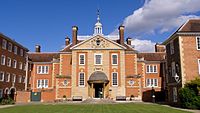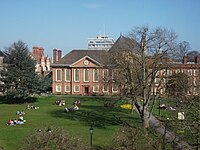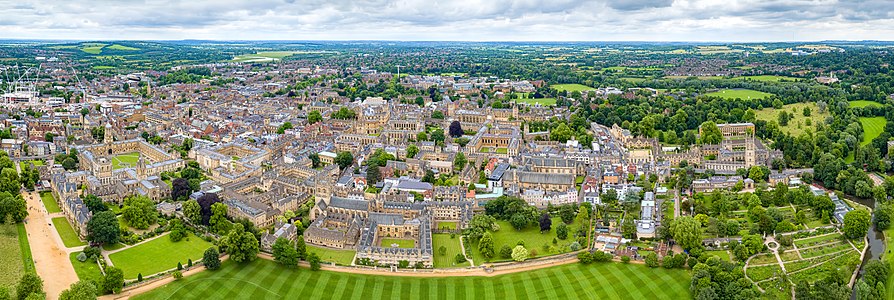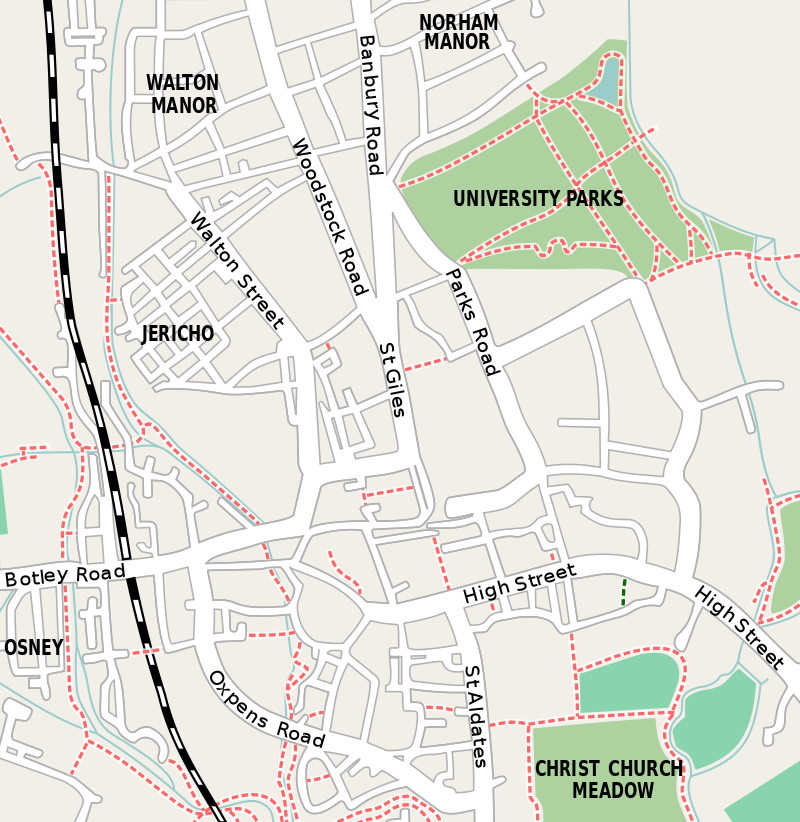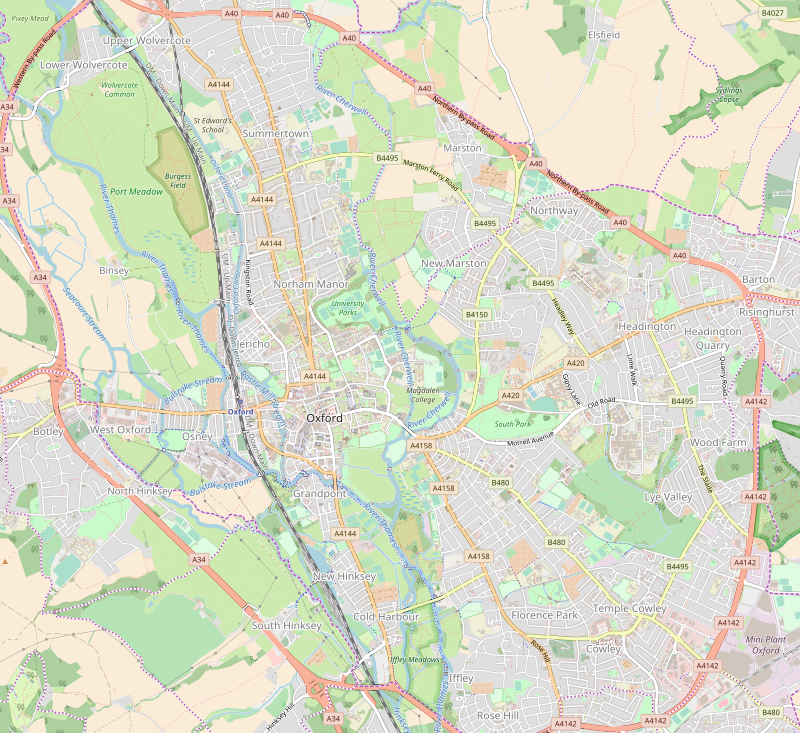
A | B | C | D | E | F | G | H | CH | I | J | K | L | M | N | O | P | Q | R | S | T | U | V | W | X | Y | Z | 0 | 1 | 2 | 3 | 4 | 5 | 6 | 7 | 8 | 9
 | |
| Latin: Universitas Oxoniensis | |
Other name | The Chancellor, Masters and Scholars of the University of Oxford[1] |
|---|---|
| Motto | Latin: Dominus illuminatio mea |
Motto in English | The Lord is my light |
| Type | Public research university Ancient university |
| Established | c. 1096[2] |
| Endowment | £8.066 billion (2023; including colleges)[5] |
| Budget | £2.924 billion (2022/23)[4] |
| Chancellor | The Lord Patten of Barnes |
| Vice-Chancellor | Irene Tracey[6] |
Academic staff | 6,945 (2022)[7] |
| Students | 26,945 (2023)[8][9] |
| Undergraduates | 12,580 |
| Postgraduates | 13,445 |
Other students | 430 |
| Location | , England 51°45′18″N 01°15′18″W / 51.75500°N 1.25500°W |
| Campus | University town |
| Colours | Oxford Blue[10] |
| Affiliations | |
| Website | ox |
 | |
The University of Oxford is a collegiate research university in Oxford, England. There is evidence of teaching as early as 1096,[2] making it the oldest university in the English-speaking world and the world's second-oldest university in continuous operation.[2][11][12] It grew rapidly from 1167, when Henry II banned English students from attending the University of Paris.[2] After disputes between students and Oxford townsfolk in 1209, some academics fled north-east to Cambridge where they established what became the University of Cambridge.[13] The two English ancient universities share many common features and are jointly referred to as Oxbridge.[14]
The University of Oxford is made up of thirty-nine semi-autonomous constituent colleges, four permanent private halls, and a range of academic departments which are organised into four divisions.[15] Each college is a self-governing institution within the university, controlling its own membership and having its own internal structure and activities. All students are members of a college.[16]
It does not have a main campus, but its buildings and facilities are scattered throughout the city centre. Undergraduate teaching at Oxford consists of lectures, small-group tutorials at the colleges and halls, seminars, laboratory work and occasionally further tutorials provided by the central university faculties and departments. Postgraduate teaching is provided in a predominantly centralised fashion.
Oxford operates the Ashmolean Museum, the world's oldest university museum; Oxford University Press, the largest university press in the world; and the largest academic library system nationwide.[17] In the fiscal year ending 31 July 2023, the university had a total consolidated income of £2.92 billion, of which £789 million was from research grants and contracts.[4]
Oxford has educated a wide range of notable alumni, including 30 prime ministers of the United Kingdom and many heads of state and government around the world.[18] As of October 2022,[update] 73 Nobel Prize laureates, 4 Fields Medalists, and 6 Turing Award winners have matriculated, worked, or held visiting fellowships at the University of Oxford, while its alumni have won 160 Olympic medals.[19] Oxford is the home of numerous scholarships, including the Rhodes Scholarship, one of the oldest international graduate scholarship programmes.
History
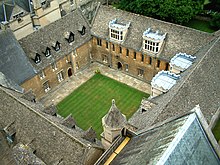

Founding
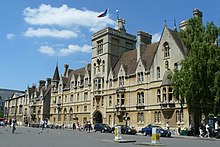
The University of Oxford's foundation date is unknown.[20] In the 14th century, the historian Ranulf Higden wrote that the university was founded in the 10th century by Alfred the Great, but this story is apocryphal.[21] It is known that teaching at Oxford existed in some form as early as 1096, but it is unclear when the university came into being.[2] Scholar Theobald of Étampes lectured at Oxford in the early 1100s.
It grew quickly from 1167 when English students returned from the University of Paris.[2] The historian Gerald of Wales lectured to such scholars in 1188, and the first known foreign scholar, Emo of Friesland, arrived in 1190. The head of the university had the title of chancellor from at least 1201, and the masters were recognised as a universitas or corporation in 1231.[2][22] The university was granted a royal charter in 1248 during the reign of King Henry III.[23]
After disputes between students and Oxford townsfolk in 1209, some academics fled from the violence to Cambridge, later forming the University of Cambridge.[13][24]
The students associated together on the basis of geographical origins, into two 'nations', representing the North (northerners or Boreales, who included the English people from north of the River Trent and the Scots) and the South (southerners or Australes, who included English people from south of the Trent, the Irish and the Welsh).[25][26] In later centuries, geographical origins continued to influence many students' affiliations when membership of a college or hall became customary in Oxford. In addition, members of many religious orders, including Dominicans, Franciscans, Carmelites and Augustinians, settled in Oxford in the mid-13th century, gained influence and maintained houses or halls for students.[27] At about the same time, private benefactors established colleges as self-contained scholarly communities. Among the earliest such founders were William of Durham, who in 1249 endowed University College,[27] and John Balliol, father of a future King of Scots; Balliol College bears his name.[25] Another founder, Walter de Merton, a Lord Chancellor of England and afterwards Bishop of Rochester, devised a series of regulations for college life;[28][29] Merton College thereby became the model for such establishments at Oxford,[30] as well as at the University of Cambridge. Thereafter, an increasing number of students lived in colleges rather than in halls and religious houses.[27]
In 1333–1334, an attempt by some dissatisfied Oxford scholars to found a new university at Stamford, Lincolnshire, was blocked by the universities of Oxford and Cambridge petitioning King Edward III.[31] Thereafter, until the 1820s, no new universities were allowed to be founded in England, even in London; thus, Oxford and Cambridge had a duopoly, which was unusual in large western European countries.[32][33]
Renaissance period

The new learning of the Renaissance greatly influenced Oxford from the late 15th century onwards. Among university scholars of the period were William Grocyn, who contributed to the revival of Greek language studies,[34] and John Colet, the noted biblical scholar.[35]
With the English Reformation and the breaking of communion with the Roman Catholic Church, recusant scholars from Oxford fled to continental Europe, settling especially at the University of Douai.[36] The method of teaching at Oxford was transformed from the medieval scholastic method to Renaissance education, although institutions associated with the university suffered losses of land and revenues. As a centre of learning and scholarship, Oxford's reputation declined in the Age of Enlightenment; enrolments fell and teaching was neglected.[37]
In 1636,[38] William Laud, the chancellor and Archbishop of Canterbury, codified the university's statutes. These, to a large extent, remained its governing regulations until the mid-19th century. Laud was also responsible for the granting of a charter securing privileges for the University Press, and he made significant contributions to the Bodleian Library, the main library of the university. From the beginnings of the Church of England as the established church until 1866, membership of the church was a requirement to graduate as a Bachelor of Arts, and "dissenters" were only permitted to be promoted to Master of Arts in 1871.[39]
The university was a centre of the Royalist party during the English Civil War (1642–1649), while the town favoured the opposing Parliamentarian cause.[40]

Wadham College, founded in 1610, was the undergraduate college of Sir Christopher Wren. Wren was part of a brilliant group of experimental scientists at Oxford in the 1650s, the Oxford Philosophical Club, which included Robert Boyle and Robert Hooke. This group, which has at times been linked with Boyle's "Invisible College", held regular meetings at Wadham under the guidance of the college's Warden, John Wilkins, and the group formed the nucleus that went on to found the Royal Society.[41]
Modern period
Students
Before reforms in the early 19th century, the curriculum at Oxford was notoriously narrow and impractical. Sir Spencer Walpole, a historian of contemporary Britain and a senior government official, had not attended any university. He said, "Few medical men, few solicitors, few persons intended for commerce or trade, ever dreamed of passing through a university career." He quoted the Oxford University Commissioners in 1852 stating: "The education imparted at Oxford was not such as to conduce to the advancement in life of many persons, except those intended for the ministry."[42] Nevertheless, Walpole argued:
Among the many deficiencies attending a university education there was, however, one good thing about it, and that was the education which the undergraduates gave themselves. It was impossible to collect some thousand or twelve hundred of the best young men in England, to give them the opportunity of making acquaintance with one another, and full liberty to live their lives in their own way, without evolving in the best among them, some admirable qualities of loyalty, independence, and self-control. If the average undergraduate carried from University little or no learning, which was of any service to him, he carried from it a knowledge of men and respect for his fellows and himself, a reverence for the past, a code of honour for the present, which could not but be serviceable. He had enjoyed opportunities... of intercourse with men, some of whom were certain to rise to the highest places in the Senate, in the Church, or at the Bar. He might have mixed with them in his sports, in his studies, and perhaps in his debating society; and any associations which he had this formed had been useful to him at the time, and might be a source of satisfaction to him in after life.[43]
Out of the students who matriculated in 1840, 65% were sons of professionals (34% were Anglican ministers). After graduation, 87% became professionals (59% as Anglican clergy). Out of the students who matriculated in 1870, 59% were sons of professionals (25% were Anglican ministers). After graduation, 87% became professionals (42% as Anglican clergy).[44][45]
M. C. Curthoys and H. S. Jones argue that the rise of organised sport was one of the most remarkable and distinctive features of the history of the universities of Oxford and Cambridge in the late 19th and early 20th centuries. It was carried over from the athleticism prevalent at the public schools such as Eton, Winchester, Shrewsbury, and Harrow.[46]
All students, regardless of their chosen area of study, were required to spend (at least) their first year preparing for a first-year examination that was heavily focused on classical languages. Science students found this particularly burdensome and supported a separate science degree with Greek language study removed from their required courses. This concept of a Bachelor of Science had been adopted at other European universities (London University had implemented it in 1860) but an 1880 proposal at Oxford to replace the classical requirement with a modern language (like German or French) was unsuccessful. After considerable internal wrangling over the structure of the arts curriculum, in 1886 the "natural science preliminary" was recognised as a qualifying part of the first year examination.[47]
At the start of 1914, the university housed about 3,000 undergraduates and about 100 postgraduate students. During the First World War, many undergraduates and fellows joined the armed forces. By 1918 virtually all fellows were in uniform, and the student population in residence was reduced to 12 per cent of the pre-war total.[48] The University Roll of Service records that, in total, 14,792 members of the university served in the war, with 2,716 (18.36%) killed.[49] Not all the members of the university who served in the Great War were on the Allied side; there is a remarkable memorial to members of New College who served in the German armed forces, bearing the inscription, 'In memory of the men of this college who coming from a foreign land entered into the inheritance of this place and returning fought and died for their country in the war 1914–1918'. During the war years the university buildings became hospitals, cadet schools and military training camps.[48]
Reforms
Two parliamentary commissions in 1852 issued recommendations for Oxford and Cambridge. Archibald Campbell Tait, a former headmaster of Rugby School, was a key member of the Oxford Commission; he wanted Oxford to follow the German and Scottish model in which the professorship was paramount. The commission's report envisioned a centralised university run predominantly by professors and faculties, with a much stronger emphasis on research. The professional staff should be strengthened and better paid. For students, restrictions on entry should be dropped, and more opportunities given to poorer families. It called for an enlargement of the curriculum, with honours to be awarded in many new fields. Undergraduate scholarships should be open to all Britons. Graduate fellowships should be opened up to all members of the university. It recommended that fellows be released from an obligation for ordination. Students were to be allowed to save money by boarding in the city, instead of in a college.[50][51]
The system of separate honour schools for different subjects began in 1802, with Mathematics and Literae Humaniores.[52] Schools of "Natural Sciences" and "Law, and Modern History" were added in 1853.[52] By 1872, the last of these had split into "Jurisprudence" and "Modern History". Theology became the sixth honour school.[53] In addition to these B.A. Honours degrees, the postgraduate Bachelor of Civil Law (B.C.L.) was, and still is, offered.[54]
The mid-19th century saw the impact of the Oxford Movement (1833–1845), led among others by the future Cardinal John Henry Newman.
Administrative reforms during the 19th century included the replacement of oral examinations with written entrance tests, greater tolerance for religious dissent, and the establishment of four women's colleges. Privy Council decisions in the 20th century (e.g. the abolition of compulsory daily worship, dissociation of the Regius Professorship of Hebrew from clerical status, diversion of colleges' theological bequests to other purposes) loosened the link with traditional belief and practice. Furthermore, although the university's emphasis had historically been on classical knowledge, its curriculum expanded during the 19th century to include scientific and medical studies.
The University of Oxford began to award doctorates for research in the first third of the 20th century. The first Oxford DPhil in mathematics was awarded in 1921.[55]
The list of distinguished scholars at the University of Oxford is long and includes many who have made major contributions to politics, the sciences, medicine, and literature. As of October 2022, 73 Nobel laureates and more than 50 world leaders have been affiliated with the University of Oxford.[18]
Women's education
The university passed a statute in 1875 allowing examinations for women at roughly undergraduate level;[56] for a brief period in the early 1900s, this allowed the "steamboat ladies" to receive ad eundem degrees from the University of Dublin.[57] In June 1878, the Association for the Education of Women (AEW) was formed, aiming for the eventual creation of a college for women in Oxford. Some of the more prominent members of the association were George Granville Bradley, T. H. Green and Edward Stuart Talbot. Talbot insisted on a specifically Anglican institution, which was unacceptable to most of the other members. The two parties eventually split, and Talbot's group founded Lady Margaret Hall in 1878, while T. H. Green founded the non-denominational Somerville College in 1879.[58] Lady Margaret Hall and Somerville opened their doors to their first 21 students (12 at Somerville, 9 at Lady Margaret Hall) in 1879, who attended lectures in rooms above an Oxford baker's shop.[56] There were also 25 women students living at home or with friends in 1879, a group which evolved into the Society of Oxford Home-Students and in 1952 into St Anne's College.[59][60]
These first three societies for women were followed by St Hugh's (1886)[61] and St Hilda's (1893).[62] All of these colleges later became coeducational, starting with Lady Margaret Hall and St Anne's in 1979,[63][59] and finishing with St Hilda's, which began to accept male students in 2008.[64] In the early 20th century, Oxford and Cambridge were widely perceived to be bastions of male privilege;[65] however, the integration of women into Oxford moved forward during the First World War. In 1916 women were admitted as medical students on a par with men, and in 1917 the university accepted financial responsibility for women's examinations.[48]
On 7 October 1920 women became eligible for admission as full members of the university and were given the right to take degrees.[66] In 1927 the university's dons created a quota that limited the number of female students to a quarter that of men, a ruling which was not abolished until 1957.[56] However, during this period Oxford colleges were single sex, so the number of women was also limited by the capacity of the women's colleges to admit students. It was not until 1959 that the women's colleges were given full collegiate status.[67]
In 1974, Brasenose, Jesus, Wadham, Hertford and St Catherine's became the first previously all-male colleges to admit women.[68][69] The majority of men's colleges accepted their first female students in 1979,[69] with Christ Church following in 1980,[70] and Oriel becoming the last men's college to admit women in 1985.[71] Most of Oxford's graduate colleges were founded as coeducational establishments in the 20th century, with the exception of St Antony's, which was founded as a men's college in 1950 and began to accept women only in 1962.[72] By 1988, 40% of undergraduates at Oxford were female;[73] in 2016, 45% of the student population, and 47% of undergraduate students, were female.[74][75]
In June 2017, Oxford announced that starting the following academic year, history students may choose to sit a take-home exam in some courses, with the intention that this will equalise rates of firsts awarded to women and men at Oxford.[76] That same summer, maths and computer science tests were extended by 15 minutes, in a bid to see if female student scores would improve.[77][78]
The detective novel Gaudy Night by Dorothy L. Sayers, herself one of the first women to gain an academic degree from Oxford, is largely set in the all-female Shrewsbury College, Oxford (based on Sayers' own Somerville College[79]), and the issue of women's education is central to its plot. Social historian and Somerville College alumna Jane Robinson's book Bluestockings: A Remarkable History of the First Women to Fight for an Education gives a very detailed and immersive account of this history.[80]
Buildings and sites
Map
| Map of the University of Oxford | |||||||||||
|---|---|---|---|---|---|---|---|---|---|---|---|
| |||||||||||
Main sites
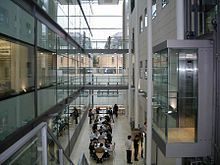

The university is a "city university" in that it does not have a main campus; instead, colleges, departments, accommodation, and other facilities are scattered throughout the city centre. The Science Area, in which most science departments are located, is the area that bears closest resemblance to a campus. The ten-acre (4-hectare) Radcliffe Observatory Quarter in the northwest of the city is currently under development.
Iconic university buildings include the Radcliffe Camera, the Sheldonian Theatre used for music concerts, lectures, and university ceremonies, and the Examination Schools, where examinations and some lectures take place. The University Church of St Mary the Virgin was used for university ceremonies before the construction of the Sheldonian.
In 2012–2013, the university built the controversial one-hectare (400 m × 25 m) Castle Mill development of 4–5-storey blocks of student flats overlooking Cripley Meadow and the historic Port Meadow, blocking views of the spires in the city centre.[81] The development has been likened to building a "skyscraper beside Stonehenge".[82]
Parks

The University Parks are a 70-acre (28 ha) parkland area in the northeast of the city, near Keble College, Somerville College and Lady Margaret Hall. It is open to the public during daylight hours.
The Botanic Garden on the High Street is the oldest botanic garden in the UK. It contains over 8,000 different plant species on 1.8 ha (4+1⁄2 acres). It is one of the most diverse yet compact major collections of plants in the world and includes representatives of over 90% of the higher plant families. The Harcourt Arboretum is a 130-acre (53 ha) site six miles (9.7 km) south of the city that includes native woodland and 67 acres (27 hectares) of meadow. The 1,000-acre (4.0 km2) Wytham Woods are owned by the university and used for research in zoology and climate change.[83]
There are also various college-owned open spaces open to the public, including Bagley Wood and most notably Christ Church Meadow.[84]
Organisation
Colleges arrange the tutorial teaching for their undergraduates, and the members of an academic department are spread around many colleges. Though certain colleges do have subject alignments (e.g., Nuffield College as a centre for the social sciences), these are exceptions, and most colleges will have a broad mix of academics and students from a diverse range of subjects. Facilities such as libraries are provided on all these levels: by the central university (the Bodleian), by the departments (individual departmental libraries, such as the English Faculty Library), and by colleges (each of which maintains a multi-discipline library for the use of its members).[85]
Central governance

The university's formal head is the Chancellor, currently Lord Patten of Barnes (due to retire in 2024), though as at most British universities, the Chancellor is a titular figurehead and is not involved with the day-to-day running of the university. The Chancellor is elected by the members of Convocation, a body comprising all graduates of the university, and may hold office until death.[86]
The Vice-Chancellor, currently Irene Tracey,[6] is the de facto head of the university. Five pro-vice-chancellors have specific responsibilities for education; research; planning and resources; development and external affairs; and personnel and equal opportunities.
Two university proctors, elected annually on a rotating basis from any two of the colleges, are the internal ombudsmen who make sure that the university and its members adhere to its statutes. This role incorporates student discipline and complaints, as well as oversight of the university's proceedings.[87] The university's professors are collectively referred to as the Statutory Professors of the University of Oxford. They are particularly influential in the running of the university's graduate programmes. Examples of statutory professors are the Chichele Professorships and the Drummond Professor of Political Economy.
The University of Oxford is only a "public university" in the sense that it receives some public money from the government, but it is a "private university" in the sense that it is entirely self-governing and, in theory, could choose to become entirely private by rejecting public funds.[88]
Colleges
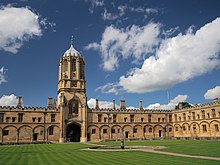

To be a member of the university, all students, and most academic staff, must also be a member of a college or hall. There are thirty-nine colleges of the University of Oxford and four permanent private halls (PPHs), each controlling its membership and with its own internal structure and activities.[16] Not all colleges offer all courses, but they generally cover a broad range of subjects.
The colleges are:
- All Souls College
- Balliol College
- Brasenose College
- Christ Church
- Corpus Christi College
- Exeter College
- Green Templeton College
- Harris Manchester College
- Hertford College
- Jesus College
- Keble College
- Kellogg College
- Lady Margaret Hall
- Linacre College
- Lincoln College
- Magdalen College
- Mansfield College
- Merton College
- New College
- Nuffield College
- Oriel College
- Pembroke College
- The Queen's College
- Reuben College
- St Anne's College
- St Antony's College
- St Catherine's College
- St Cross College
- St Edmund Hall
- St Hilda's College
- St Hugh's College
- St John's College
- St Peter's College
- Somerville College
- Trinity College
- University College
- Wadham College
- Wolfson College
- Worcester College
The permanent private halls were founded by different Christian denominations. One difference between a college and a PPH is that whereas colleges are governed by the fellows of the college, the governance of a PPH resides, at least in part, with the corresponding Christian denomination. The four current PPHs are:
The PPHs and colleges join as the Conference of Colleges, which represents the common concerns of the several colleges of the university, to discuss matters of shared interest and to act collectively when necessary, such as in dealings with the central university.[89][90] The Conference of Colleges was established as a recommendation of the Franks Commission in 1965.[91]
Teaching members of the colleges (i.e. fellows and tutors) are collectively and familiarly known as dons, although the term is rarely used by the university itself. In addition to residential and dining facilities, the colleges provide social, cultural, and recreational activities for their members. Colleges have responsibility for admitting undergraduates and organising their tuition; for graduates, this responsibility falls upon the departments.
Finances
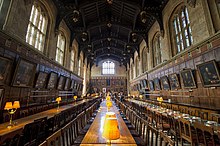
In 2017–18, the university had an income of £2,237m; key sources were research grants (£579.1m) and academic fees (£332.5m).[92] The colleges had a total income of £492.9m.[93]
While the university has a larger annual income and operating budget, the colleges have a larger aggregate endowment: over £6.4bn compared to the university's £1.2bn.[94] The central University's endowment, along with some of the colleges', is managed by the university's wholly-owned endowment management office, Oxford University Endowment Management, formed in 2007.[95] The university used to maintain substantial investments in fossil fuel companies.[96] However, in April 2020, the university committed to divest from direct investments in fossil fuel companies and to require indirect investments in fossil fuel companies be subjected to the Oxford Martin Principles.[97][98]
The total assets of the colleges of £6.3 billion also exceed total university assets of £4.1 billion.[93][92] The college figure does not reflect all the assets held by the colleges as their accounts do not include the cost or value of many of their main sites or heritage assets such as works of art or libraries.[99]
The university was one of the first in the UK to raise money through a major public fundraising campaign, the Campaign for Oxford. The current campaign, its second, was launched in May 2008 and is entitled "Oxford Thinking – The Campaign for the University of Oxford".[100] This is looking to support three areas: academic posts and programmes, student support, and buildings and infrastructure;[101] having passed its original target of £1.25 billion in March 2012, the target was raised to £3 billion.[102] The campaign had raised a total of £2.8 billion by July 2018.[92]
Funding criticisms
The university has faced criticism for some of its sources of donations and funding. In 2017, attention was drawn to historical donations including All Souls College receiving £10,000 from slave trader Christopher Codrington in 1710,[103] and Oriel College having receiving taken £100,000 from the will of the imperialist Cecil Rhodes in 1902.[104][105] In 1996 a donation of £20 million was received from Wafic Saïd who was involved in the Al-Yammah arms deal,[106][107] and taking £150 million from the US billionaire businessman Stephen A. Schwarzman in 2019.[108] The university has defended its decisions saying it "takes legal, ethical and reputational issues into consideration".
The university has also faced criticism, as noted above, over its decision to accept donations from fossil fuel companies having received £21.8 million from the fossil fuel industry between 2010 and 2015[109] and £18.8 million between 2015 and 2020.[110][111]
The university accepted £6 million from The Alexander Mosley Charitable Trust in 2021. Former racing driver Max Mosley said he set up the trust "to house the fortune he inherited" from his father,[112] Oswald Mosley, who was founder of two far right groups: Union Movement and the British Union of Fascists.[113]
Affiliations
Oxford is a member of the Russell Group of research-led British universities, the G5, the League of European Research Universities, and the International Alliance of Research Universities. It is also a core member of the Europaeum and forms part of the "golden triangle" of highly research intensive and elite English universities.[114]

